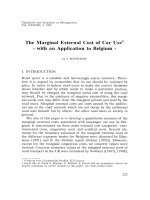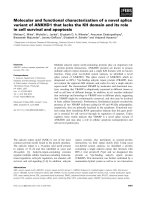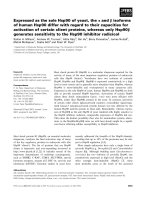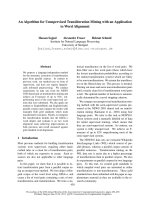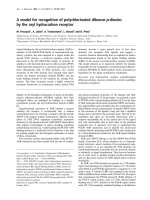A methodology for validation of integrated systems models with an application to coastal-zone management in south-west sulawesi
Bạn đang xem bản rút gọn của tài liệu. Xem và tải ngay bản đầy đủ của tài liệu tại đây (1.89 MB, 139 trang )
A METHODOLOGY FOR
VALIDATION OF INTEGRATED SYSTEMS MODELS
WITH AN APPLICATION TO COASTAL-ZONE
MANAGEMENT IN SOUTH-WEST SULAWESI
Tien Giang Nguyen
Promotion committee:
Prof. dr.ir. H.J. Grootenboer
Prof. dr. P.G.E.F. Augustinus
Prof. dr. S.J.M.H. Hulscher
Dr. J.L. de Kok
University of Twente, chairman/secretary
University of Utrecht, promoter
University of Twente, promoter
University of Twente, assistant promoter
Prof. dr.ir. A.Y. Hoekstra
Prof. dr.ir. H.G. Wind
Prof. dr.ir. A.E. Mynett
Prof. dr. S.M. de Jong
Dr. M.J. Titus
University of Twente
University of Twente
UNESCO-IHE / WL | Delft Hydraulics
University of Utrecht
University of Utrecht
ISBN 90-365-2227-7
Printed by: PrintPartners Ipskamp, Enschede
Copyright © 2005 Tien Giang Nguyen. All rights reserved.
A METHODOLOGY FOR
VALIDATION OF INTEGRATED SYSTEMS MODELS
WITH AN APPLICATION TO COASTAL-ZONE
MANAGEMENT IN SOUTH-WEST SULAWESI
DISSERTATION
to obtain
the doctor’s degree at the University of Twente,
on the authority of the rector magnificus,
prof.dr. W.H.M. Zijm,
on account of the decision of the graduation committee,
to be publicly defended
on Friday August 26, 2005 at 15.00
by
Tien Giang Nguyen
born on April 12, 1976
in Hanoi
This dissertation has been approved by:
prof. dr. P.G.E.F. Augustinus
prof. dr. S.J.M.H. Hulscher
dr. J.L. de Kok
Promoter
Promoter
Assistant Promoter
To the memory of my father
Contents
Preface…….………………………………………………………………………
11
1. Introduction…………………………………………………...….…………...
13
1.1. General introduction……………………………………………….……...
1.2. Background………………………………………………………….…….
1.2.1. Systems approach…………………………………………………...
1.2.2. Integrated approach and Integrated Assessment……………………
1.2.3. Integrated management and policy analysis………………...….......
1.3. The problem of validating Integrated Systems Models…………………..
1.4. Research aim and research questions…………………………….............
1.5. Case study description……………………………………………………
1.5.1. RaMCo……………………………………………………………...
1.5.2. Study area…………………………………………………………..
1.6. Outline of the thesis………………………………………………………
13
14
14
19
21
23
25
26
26
27
31
2. Methodology……….…..………..…………………………………………….
33
2.1. Introduction......…………… ……………………………………………..
2.2. Literature review………………………………………………………….
2.3. Concept definition.……………………… ………………………….........
2.4. Conceptual framework of analysis…………………………………..........
2.5. Procedure for validation…………………………………………..............
2.6. Conclusion………………………………………………………………...
33
34
36
38
40
42
3. Validation of an integrated systems model for coastal-zone management
using sensitivity and uncertainty analyses……………………………………...
45
3.1. Introduction......……… …………………………………………………..
3.2. Methodology….……………………………………………..……………
3.2.1. Basics for the method………………………………………………
3.2.2. The testing procedure………………………………………………
3.2.3. The sensitivity analysis………………………………………..........
3.2.4. The elicitation of expert opinions……………………………..........
3.2.5. The uncertainty propagation……………………………………......
3.2.6. The validation tests…………………………………………………
3.3. Results…………………………………………………………………….
3.3.1. Sensitivity analysis………………………………………………….
3.3.2. Elicitation of expert opinions……………………………………….
45
46
46
47
47
49
50
51
51
51
51
8
Contents
3.3.3. Uncertainty analysis………………………………………………...
3.3.4. Parameter-Verification test………………………………………….
3.3.5. Behaviour-Anomaly test…………………………………………….
3.3.6. Policy-Sensitivity test……………………………………………….
3.4. Discussion and conclusions……………………………………………….
3.5. Appendices…………………………………………..................................
57
59
59
60
60
62
4. A new approach to testing an integrated water systems model using
qualitative scenarios……………………………………………………...............
65
4.1. Introduction……………………………………………...………..............
4.2. Validation methodology.… ………………………………..……………..
4.2.1. Overview of the new approach…………………………………......
4.2.2. The detail procedure………………………………………………...
4.3. The RaMCo model…………………………………………………..........
4.3.1. Land-use/land-cover change model…………………………………
4.3.2. Soil loss computation……………………………………………….
4.3.3. Sediment yield………………………………………………………
4.4. Formulation of scenarios for testing………………………………………
4.4.1. Structuring scenarios………………………………………………..
4.4.2. Developing qualitative scenarios for testing………………..............
4.5. Translation of qualitative scenarios……………………………………….
4.5.1. Fuzzification………………………………………………………...
4.5.2. Formulation of inference rules……………………………………...
4.5.3. Application of the inference rules………………………………......
4.5.4. Calculation of the output value…………………………………......
4.5.5. Testing the consistency of the scenarios……………………………
4.6. Results…………………………………………………………………….
4.7. Discussion and conclusions………………………………………………
65
66
66
67
69
70
72
73
73
74
75
77
77
78
81
81
81
82
84
5. Validation of a fisheries model for coastal-zone management in
Spermonde Archipelago using observed data………………………………….
87
5.1. Introduction…………………………………………………...……..........
5.2. Case study.…………………… …………………..….…………………..
5.2.1. Fisheries in the Spermonde Archipelago, Southwest Sulawesi……..
5.2.2. Fisheries modelling in RaMCo………………………………….......
5.2.3. Data source and data processing…………………………………….
5.3. Validation methodology………………………………………..................
5.3.1. Sate of the art………………………………………………………..
5.3.2. The proposed method……………………………………………….
5.3.3. Fishery production models………………………………………….
5.4. Results…………………………………………………………………….
5.4.1. Calibration…………………………………………………..............
5.4.2. The pattern test……………………………………………………...
5.4.3. The accuracy test…………………………………………................
5.4.4. The extreme condition test………………………………………….
5.5. Discussion and conclusions……………………………………………….
87
88
88
89
90
91
91
93
94
95
95
97
100
100
100
Contents
9
6. Discussions, conclusions and recommendations…………………….............
103
6.1. Introduction………………………………………...……………………..
6.2. Discussions.……… ………………………..….………………………….
6.2.1. Innovative aspects……………………………….…….. …………..
6.2.2. Generic applicability of the methodology…………………………..
6.2.3. Limitations………………………………………………………….
6.3. Conclusions……………………………………………………………….
6.3.1. Concept definition………………………………………………….
6.3.2. Methodology………………………………………………………..
6.4. Recommendations………………………………………………………...
6.4.1. Other directions for the validation of integrated systems models…..
6.4.2. Proper use of integrated systems models…………………………...
103
103
103
104
104
105
105
106
109
109
110
References………………………………………………………………………..
111
Symbols……………………………………………………………………………
123
Acronyms and abbreviations…………………….................................................
127
Summary………………………………………………………………………….
129
Samenvatting……………………………………………………………………...
133
About the author……………………………………………………….................
139
10
Contents
Preface
Words are easily borrowed, but the emotional meaning from one’s heart is difficult to
describe. Therefore, I would like to ask for the forgiveness from those whose assistance
cannot be appreciated in words and from those who, by any chance, I forgot to mention.
First of all I would like to thank prof. dr.ir. Herman Wind and his wife - Joke. The
interviews prof. Wind held in Bangkok and the decision he made enabled me to be here,
at Twente University, to fulfil my PhD research. Herman and Joke, I will never forget
the first meeting we had in Bangkok in April, 2001. Khap khun ma khap.
The next person I want to thank is dr. Jean-Luc de Kok, my daily supervisor. His
cleverness and intellectual skills have convinced me that I would be able to complete
this thesis with his regular guidance. His tireless support during the four-year period of
the research, in every aspect, made ‘my wish’ to come true. Jean-Luc, I am very happy
to be your first PhD student. The contents of the thesis belong to both you and me.
Importantly, I would like to thank my two promoters, prof. dr. Suzanne Hulscher and
prof. dr. Pieter Augustinus and my former promoter, prof. dr. Kees Vreugdenhil. Their
outstanding knowledge and experience in both science and management resulted in this
thesis. I would like to thank you all for that. Specifically, thank you, Pieter, for your
kindness, patience and useful comments during the preparation of the manuscript.
I would like to thank the Netherlands Foundation for the Advancement of Tropical
Research (WOTRO). The funding given to both the original Buginesia project and the
resulting project, which is presented in this thesis, has been provided by this
organisation.
It is also necessary to mention in particular a number of people from different
institutions in the Netherlands and in Indonesia, who have been actively involved in the
Buginesia project and contributed to this research. From Utrecht University, dr. Milan
Titus, prof. dr. Steven De Jong, prof. dr. Piet Hoekstra; From ITC, dr. A. Sharifi and dr.
Tjeerd Hobma; From UNESCO-IHE, prof. dr. ir. Arthur Mynett; From other Dutch
institutions: dr. Lida Pet-Soede, dr. Maya Borel Best, dr. Wim van Densen and prof. dr.
Leontine Visser; From the University Hasanuddin (UNHAS), prof. dr. Dadang Ahmad,
prof. dr. Alfian Noor and mr. Mushta;. I have learnt a lot from you all. Thank you very
much for your fruitful cooperation.
Social interaction plays an important role in one’s research career. Therefore, I want to
thank all colleagues inside and outside of the WEM group for making my working years
here lively. Particularly, Huong Thi Thuy Phan; two pretty office-mates: Saskia and
12
Preface
Schretlen; people in the soccer team of the WEM group: Jan, Daniel, Martijn Booij,
Maarten, Pieter Roos, Jebbe, Pieter Oel, Andrei, Freak, Judith, Daniella, Steven,…and
their partners; Roos, Rolnan, Cornelie, Judith and Wendy from the Construction and
Transport groups; Our secretaries: Anke, Joke and Ellen; Yan, Dong, Ping, Chang Wei
and Jan from the ‘Chinese community’. Dank je wel and Xie xie.
The work of preparing, distributing, and collecting the questionnaires from the endusers of RaMCo (Chapter 3) was done by Tessa Hofman. Arif Wismadi collected the
socio-economic data for validating the model of land-use and land-cover changes
(Chapter 4). Christian Loris collected the data and processed a part of them for
validating the fisheries model (Chapter 5). Gay Howells checked the English of the final
manuscript. Thank the four of you for what you have done to make this thesis complete.
My gratefulness goes to all of my Vietnamese friends living in the Netherlands, but
particularly to Hien-Nhu, Hieu-Lam, Kim-V.Anh, Phuong-Ha, Tu-An, Duy-Chi, ThangMai, Trung-Thanh, Ha-Huong, Nhung, Hanh, Long, Kien, Hoa and Cuong. Dear
friends, to be your friends in Twente makes me feel like being at home.
Hoang Tu and Jebbe van der Werf deserve the special thanks for what makes me ask
them to be my ‘paranimfen’. Dank je wel, Jebbe, you are my closest Dutch friend. Tu,
many thanks for the daily-life things we have been sharing.
Almost the last person I want to thank here is my beloved girlfriend - Hue Chi. She is
always with me when I need her most. The four-year period of doing research would
have been much more difficult without her. Darling, I love you so very much.
Lastly but most importantly, I would like to express my deepest gratefulness to my
family, including my father, Nguyen Dinh Thinh, my mother, Ly Thi Nguyet and my
little sister, Nguyen Thanh Thuy. They are the people that support me the most. Father!
One paragraph of thankful words is absolutely far from enough for what you had done
for me. The whole spirit of this thesis is devoted to you. In Heaven, you would be
smiling….
Nguyen Tien Giang
Enschede, July, 2005.
Chapter 1
Introduction
1.1. General introduction
Systems approach and integrated approach towards the planning and management of
natural resources and environment are considered as promising approaches to achieve
the sustainable development of a region, of a country, and of our common world.
Consequently, an increasing number of Integrated Systems Models (ISMs) have been
developed (e.g. Hoekstra, 1998; Turner, 2000; De Kok and Wind, 2002). However, the
scarcity of field data for both model development and model validation, the lack of
knowledge about the relevant internal and external factors of the real system and the
model high aggregation levels (increase in scope but decrease in detail) create a number
of critical questions such as: to what extent can such models contribute to our
knowledge and ability to manage our environment? Are they useful and do they have an
added value in comparison with conventional process models? Centred in these
questions are the two questions: What is the validity of an ISM? How can this validity
be determined and established? This thesis is aimed at addressing these two questions.
Rapid Assessment Model for Coastal-zone Management (RaMCo), which was
developed by a Dutch-Indonesian multidisciplinary team (De Kok and Wind, 1999),
serves as a case study to achieve the objective of the thesis. The theoretical justification
for this choice is that RaMCo contains the typical characteristics of an Integrated
Systems Model. The first characteristic is reflected in the RaMCo’s ability to take into
account the interactions of socio-economic developments, biophysical conditions and
policy options. The second characteristic is the inclusion of the linkages between many
processes pertaining to different scientific fields, such as marine pollution, land-use
change, catchment hydrology, coastal hydrodynamics, fisheries and regional economic
development. Practically, the model was chosen since its validation had not been carried
out in the original project. In addition, the availability of the measured data (from 1996
until now) allows for the application of quantitative techniques which are suitable for
the validation of ISMs. It is aware that, despite the typicality of RaMCo, other ISMs
may differ in some aspects from the model considered. Therefore, the generality of the
validation methodology established is discussed in the final chapter of the thesis.
The introductory chapter is organised as follows. Section 1.2 describes the concepts of
systems approach, integrated approach and how they fit into the framework of the
natural resources and environmental management. The role of ISMs as tools to facilitate
this integrated management is explained. Difficulties involved with validation of these
models are elaborated in Section 1.3. The research questions and sub-questions of the
thesis are formulated in Section 1.4. A description of the case study is given in Section
1.5. The outline of the thesis is included in Section 1.6.
14
Chapter1
1.2. Background
1.2.1. Systems approach
Systems approach or systemic approach was born from the cross-fertilization of several
disciplines: information theory (Shannon, 1948), cybernetics (Wiener, 1948), and
general systems theory (Von Bertalanffy, 1968) more than half a century ago. As
described by Rosnay (1979), it is not to be considered a "science," a "theory," or a
"discipline," but a new methodology that makes possible the collection and organization
of accumulated knowledge in order to increase the efficiency of our actions.
The systemic approach, as opposed to the analytical approach, includes the totality of
the elements in the system under study, as well as their interaction and interdependence.
It is based on the conception of systems. The systems approach got its well-known
status after the two publications related to the depletion of world’s natural resources
(Forrester, 1971; Meadows et al., 1972). To clarify the concept of systems approach,
others approaches, with which it is often confused, are briefly mentioned.
- The systemic approach goes beyond the cybernetics approach (Wiener, 1948), whose
main objective is the study of control in living organisms and machines.
- It must be distinguished from General Systems Theory (Von Bertalanffy, 1968),
whose purpose is to describe in mathematical language the totality of systems found in
nature.
- It is not the same as systems analysis (Miser and Quade, 1985), a method that
represents only one tool of the systemic approach. The system analysis is elaborated
later in Section 1.2.3.
- The systemic approach has nothing to do with a systematic approach that confronts a
problem or sets up a series of actions in sequential manner, in a detailed way, forgetting
no element and leaving nothing to chance.
The analytic approach seeks to reduce a system to its elementary elements in order to
study them in detail and understand the types of interaction that exist between them. By
modifying one variable at a time, it tries to infer general laws that will enable to predict
the properties of a system under very different conditions. To make this prediction
possible, the laws of the additivity of elementary properties must be invoked. This is the
case in homogeneous systems, those composed of similar elements and having weak
interactions among them. Here the laws of statistics readily apply, enabling to
understand the behaviour of the disorganized complexity. The laws of the additivity of
elementary properties do not apply in highly complex systems composed of a large
diversity of elements linked together by strong interactions. These systems must be
approached by new methods such as those that the systemic approach groups together.
The purpose of the new methods is to consider a system in its totality, its complexity,
and its own dynamics. Through simulation one can "animate" a system and observe in
real time the effects of the different kinds of interactions among its elements. The study
of this behaviour leads in time to the determination of rules that can modify the system
or design other systems.
Introduction
15
Systems Concepts
Various definitions of concepts of systems can be found in the literature (see Van
Gigch, 1974; Rosnay, 1979; Kramer and De Smit, 1991). Following Kramer and De
Smit (1991), a system is defined as a collection of entities together with the collection of
relationships existing between these entities. An entity (element) is the component of
the system. In principle any system can be decomposed into subsystems, a process
which can be repeated as many times as the number of distinguishable hierarchic or
aggregation levels the system comprises. The entities of the system at a lower hierarchic
level and their interrelationships constitute the subsystems at that level. The choice of
system entities simultaneously fixes the level of aggregation, and is not a trivial matter.
In principle the level of aggregation depends on the purpose of the system model.
The structure of a system is also differently defined in the literature. A structure of a
system, in view of systems modelling, can comprise: a spatial arrangement of elements,
ordered levels (hierarchy) of subsystems or/and elements, and concentration and types
of algebraic relationships between subsystems and/or elements. These three factors,
together with the variety of elements (related to ordered levels), determine the
complexity of a system. An extremely complex system model can be characterized by a
rich variety of elements, a heterogeneous and irregular distribution of elements in space,
many hierarchic levels, and nonlinear algebraic relationships between the elements. The
complexity of a system is dependent on its nature and its boundaries.
The boundaries of a system separate the system from its environment. There are two
types of boundary: physical and conceptual boundaries. The physical boundary
determines the spatial scope of the system (e.g. a coastal zone) while the conceptual
boundary differentiates exogenous from endogenous variables. Exogenous (i.e. external
or independent) variables are those whose values arise independently of the endogenous
(i.e. internal) variables. A closed system is a self-contained system without connections
to exogenous variables. Oreskes et al. (1994), in arguing against the possibility of
validating predictive models, indicate that an open system is a system which is not well
defined (uncertain parameters, state variables, boundaries, etc.). Examples of open
systems are: groundwater systems, social systems, as well as most of the natural
systems.
Four types of variables characterize a model of a system (Kramer and De Smit, 1991):
input variables, state variables, control variables, and output variables. The output
variables of a system depend on the structure of the system (e.g. a transfer function)
together with the input variables, control variables and state variables. Considering a
system element with an input variable x(t), a state variable s(t), a control variable c(t)
and an output variable y(t) as shown in Fig.1.1, the dynamic (time dependent) behaviour
of this system element is governed by the following equations:
y (t ) = f ( x(t ), c(t ), s(t ) )
(1.1)
∂s (t )
= g ( x (t ), c (t ), s (t ) )
∂t
(1.2.)
16
Chapter1
c(t)
x(t)
y(t)
s(t)
Fig. 1.1. General model of a system (Kramer and De Smit, 1991)
System dynamics
System Dynamics (SD) is a modelling approach which considers the structural system
as a whole, focusing on the dynamic interactions between the components as well as on
the behaviour of the complete system. SD was generalized from Industrial Dynamics
(Forrester, 1961) and Urban Dynamics (Forrester, 1969), developed by Jay W.
Forrester, at the Massachusetts Institute of Technology. This discipline is based on
systems theory, control theory and the modern theory of nonlinear dynamics. There are
some important concepts relevant to system dynamics: feedback, stocks and flows,
mode and behaviour, time delays, and nonlinearity (Sterman, 2002) which require
elaboration.
Positive and Negative Feedback
In a system where a transformation occurs, there are inputs and outputs. The inputs are
the result of the environment's influence on the system, and the outputs are the influence
of the system on the environment. Input and output are separated by duration of time, as
in before and after, or past and present (Fig. 1.2).
INPUT
SYSTEM
BEFORE
OUTPUT
AFTER
TIME
FEEDBACK
INPUT
SYSTEM
OUTPUT
Fig. 1.2. System input-output and feedback (Rosnay, 1979)
Introduction
17
In every feedback loop, as the name suggests, information about the result of a
transformation or an action is sent back to the input of the system in the form of input
data. If these new data facilitate and accelerate the transformation in the same direction
as the preceding results, they are positive feedback; their effects are cumulative. If the
new data produce a result in the opposite direction to previous results, they are negative
feedback; their effects stabilize the system. In the first case there is exponential growth
or decline; in the second case the equilibrium can be reached (Fig. 1.3).
EXPLOSION
THERE IS NO INTERMEDATE SITUATION
SITUATION AT
THE START
EQUILIBRIUM
SITUATION AT
THE START
GOAL
BLOCKING
SITUATION AT
THE START
TIME
POSITIVE FEEDBACK
EXPONETIAL GROWTH AND DIVERGENT BEHAVIOR
TIME
NEGATIVE FEEDBACK
MAINTENANCE OF EQUILIBRIUM AND CONVERGENCE
Fig. 1.3. Positive and negative feedback (Rosnay, 1979)
Positive feedback leads to divergent behaviour: indefinite expansion or explosion (a
running away toward infinity) or total blocking of activities (a running away toward
zero). Each plus involves another plus; it causes a snowball effect. Some examples are
the population growth, industrial expansion, capital invested at compound interest,
inflation, and proliferation of cancer cells. However, when minus leads to another
minus, events come to a standstill. Typical examples are bankruptcy and economic
depression.
Stocks and flows
The dynamic behaviour of every system, regardless of its complexity, depends
ultimately on two kinds of variables: flow variables and state variables. The first are
symbolized by the valves that control the flows, the second (showing what is contained
in the reservoirs) by rectangles. The flow variables are expressed only in terms of two
instants, or in relation to a given period, and thus are basically functions of time. The
state (level) variables indicate the accumulation of a given quantity in the course of
time; they express the result of integration. If time stops, the level remains constant
(static level) while the flows disappear - for they are the results of actions. Hydraulic
examples are the easiest to understand. The flow variable is represented by the flow
rate, that is, the average quantity running off between two instants. The state variable is
the quantity of water accumulated in the reservoir at a given time. If the flow of water is
replaced by a flow of people (number of births per year), the state variable becomes the
population size at a given moment.
18
Chapter1
Modes and behaviour of systems
The properties and the behaviour of a complex system are determined by its internal
organization and its relations with its environment. To understand better these properties
and to anticipate better its behaviour, it is necessary to act on the system by
transforming it or by orienting its evolution.
Every system has two fundamental modes of existence and behaviour: maintenance and
change. The first mode, based on negative feedback loops, is characterized by stability.
Growth (or decline) characterizes the second mode, based on positive feedback loops.
The coexistence of the two modes at the heart of an open system, constantly subject to
random disturbances from the system’s environment, creates a series of common
behaviour patterns. The principal patterns can be summarized in a series of simple
graphs by taking a variable or any typical parameter of the system (size, output, total
sales, and number of elements) as a function of time (Fig. 1.4).
STAGNATION
LINEAR GROWTH
ACCELERATE GROWTH
(POSITIVE FEEDBACK)
STABILIZATION AT ONE
EQUILIBRIUM VALUE
(NEGATIVE FEEDBACK)
EXPONETIAL GROWTH
AND REGULATION
EQUILIBRIUM
DECLINE
LIMIT
LIMITED GROWTH
OCILATIONS AND
FLUCTUATIONS
ACCELERATED GROWTH
AND SATURATION
Fig. 1.4. System behaviour patterns (Rosnay, 1979)
Introduction
19
1.2.2. Integrated approach and Integrated Assessment
The previous description of the systems approach indicates that the concept of
integration only entered in the later stage of the evolvement of systems approach and is
limited in integrating disciplines. The new requirements, for example involvement of
stakeholders, interaction of different processes at different spatial and temporal scales,
and sustainable development, promote a more advanced approach. This approach is
referred to as ‘integrated approach”.
The term ‘integrated’ is often used interchangeably with the term ‘holistic’. Schreider
and Mostovaia (2001), however, formulate the differences between integrated (in the
sense of holistic) approach and Integrated Assessment (in the sense of
multidisciplinary). They consider an Integrated Assessment (IA) to be “integrated” in a
holistic sense, if it can provide new qualitative knowledge, which cannot be obtained
from each component of the IA. However, this separation becomes blurred when one
considers a later definition of IA (Van Asselt, 2000):
Integrated Assessment is a structured process of dealing with complex issues, using
knowledge from various scientific disciplines and/or stakeholders, in such a manner
that integrated insights are made available to responsible decision-makers.
Van Asselt also mentions that: Integrated assessments should have an added value
compared to insights derived from disciplinary research. An integrated approach
ensures that key interactions, feedbacks and effects are not inadvertently omitted from
the analysis. It is clear that the integrated (in the sense of holistic) approach has been
incorporated in the framework of IA. Therefore, instead of differentiating the integrated
approach from IA, it is useful to clarify the meanings of ‘integrated’ and ‘integration’.
As mentioned by Scrase and Sheate (2002), definitions of assessment and integration
unfortunately only add to the lack of precision and clarity surrounding the discourse.
Therefore, their uses in different contexts are investigated to extract the meanings that
they have implied. Meijerink (1995) described the integrated approach to water
management as a management method which requires an integration of three
interrelated systems: natural (water system), socio-economic (water users) and
administrative (water management). Janssen and Goldsworthy (1996) formulate
‘integration’ in the context of multidisciplinary research for natural resource
management. Following Lockeretz (1991), they distinguish four forms of integration:
additive, non-disciplinary, integrated, and synthetic. The disciplinary integration, which
is involved with the respectful interactions among disciplinary scientists, forms the
integrated research or interdisciplinary research. Rotmans and De Vries (1997) consider
several aspects of integration. In studying closed systems, they describe the first aspect
which involves two dimensions of integration: vertical and horizontal. The vertical
integration is based on the causal chain. This integration closes the causal loop, linking
the pressure (stimulus or input) to a state (state variable), a state to impact (objective
variable or output), impact to response (control variable), and a response to a pressure.
The horizontal integration addresses the cross-linkages and interactions between
pressures, states, impacts and responses for the various subsystems distinguished in the
integrated model. The second aspect of integration is that it should bridge what is
usually referred to as the domains of natural and social sciences. Parker et al. (2002)
20
Chapter1
suggest that there are at least five different types of integration within the framework of
Integrated Assessment Modelling (IAM). These are integrations of disciplines, of
models, of scales, of issues, and of stakeholders. Scrase and Sheate (2002) give a more
detailed and critical review on the uses and meanings of integration, integrated approach
and integrated assessment. They found fourteen aspects subject to integration in
different governance and assessment contexts, such as industry, regulation, planning
and politics. These aspects are summarised in Table 1.1.
Table 1.1. Meanings of integration in environmental assessment and governance (After
Scrase and Sheate, 2002).
Meaning
Main focus
1) Integrated information resources
Facts/data
2) Integration of environmental concerns into
governance
Environmental values
3) Vertically integrated planning and
management
Tiers of governance
4) Integration across environmental media
Water, land and air
5) Integrated environmental management
(regions)
Ecosystems
6) Integrated environmental management
(production)
Engineering systems
7) Integration of business concerns into
governance
Capitalist values
8) Triplet of environment – economy – society
Development values
9) Integration across policy domains
Functions of governance
10) Integrated environmental-economic
modelling
Computer models
11) Integration of stakeholders into governance Participation
12) Integration among assessment tools
Methodologies/procedures
13) Integration of equity concerns into
governance
Equity/socialist values
14) Integration of assessment into governance
Decision/policy context




